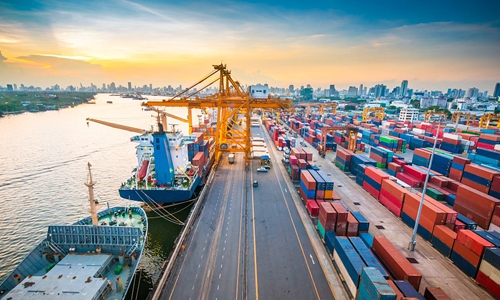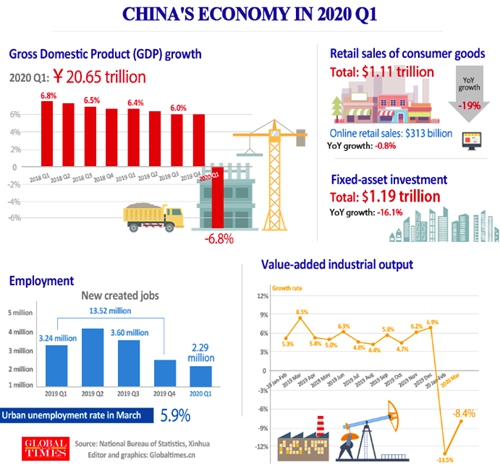What's next for China after record 6.8% GDP fall?
By Wang Cong Source:Global Times Published: 2020/4/17 19:35:30 Last Updated: 2020/4/17 23:40:26

Photo: VCG
China on Friday provided the clearest and most complete picture yet of the economic cost of the deadly coronavirus, which has so far taken 4,642 Chinese lives. With first-quarter GDP shrinking 6.8 percent, the first decline since 1992 when quarterly data began to be reported, the damage amounts to an eye-popping 1.44 trillion yuan ($203.4 billion) in lost output, equivalent to the entire New Zealand economy in 2018.
This grim milestone also foreshadows the enormous pain that the COVID-19 pandemic could inflict on other major economies, which are still in the epidemic mitigation process, and on the global economy as a whole. They are all in dire need of hope and support from the world's second-largest economy and its biggest growth engine.
While many paint a dark picture of the Chinese economy going forward, and some even say that its four-decade growth miracle has come to an end, Chinese officials, economists and ordinary citizens alike offer a more balanced and nuanced reading of the data: the short-term pain is enormous, but the country remains resilient in the face of an unprecedented challenge and economic expansion still has huge potential as the recovery accelerates.
Their resounding message is that the long-term growth path of the Chinese economy has not changed because of the epidemic's short-term shock.

GT Graphic
Enormous loss
The record-shattering data came as a surprise to almost no one in China, where everyone saw much of the nation brought to a near-standstill for most of the first quarter by the virus itself and the swift measures to contain it, with production halted, businesses shuttered and consumers trapped in their homes - all part of the country's robust measures to stop the virus and save lives.
"It's no surprise at all. In fact, it falls right in the range of market expectations," Guan Tao, a former senior official of the State Administration of Foreign Exchange, told the Global Times, pointing to contractions in every sector of the economy from agriculture to manufacturing to services, as well as the evaporation of domestic consumption, investment and foreign demand.
The secondary sector - manufacturing - recorded the biggest decline of 9.6 percent year-on-year, followed by the tertiary sector - services - with a 5.2-percent fall, and a contraction of 3.2 percent in the primary sector - agriculture and mining, data from the National Bureau of Statistics (NBS) showed.
On the demand side, retail sales fell 19 percent, fixed-asset investment dropped 16.1 percent and exports slid 11.4 percent.
"The 6.8 percent decline … realistically reflected the actual impact of the epidemic on economic operations," said Guan Qingyou, chief economist at the Beijing-based Reality Institute of Advanced Finance and a Chinese government economic policy advisor.
But underneath the unprecedented GDP contraction is the deep pain felt directly and indirectly by people in almost all walks of life - from white-collar workers in the Beijing's central business district to migrant workers in rural mountain areas of Southwest China's Sichuan Province, and in every corner - from factory floors in the manufacturing base of East China's Zhejiang Province to the cotton fields in the westernmost autonomous region of Xinjiang.
"What you just said about the GDP means literally nothing to me. All I know is that I have been stuck at home so far this year and haven't earned a penny," said Mao Guhuo, a migrant worker in Liangshan Yi Autonomous Prefecture in Sichuan, whose plan to go to Southwest China's Tibet Autonomous Region was scrapped due to strict anti-epidemic controls.
In Beijing, Qu Mu, a worker in the film industry - which was already in a slump before the epidemic - said there had been no projects at all, and he has had to take up a side job of selling masks, but that too has been affected as tougher regulations are implemented to ensure quality. "I think I am not the only one who feels this. We are in a worldwide crisis," he told the Global Times.
Nationwide, urban unemployment stood at 5.9 percent as of the end of the first quarter, though improving in March from the all-time high of 6.2 percent in February, according to official data. Per capita disposable income only saw 0.8-percent growth to $1,209 in the first quarter.
Indeed, China's pain will also be felt by other major economies as the virus continues to ravage the globe. The US economy could shrink 10 percent in the first quarter and 25 percent in the second quarter, according to JP Morgan. India's GDP, one of the fastest-growing in the world, could contract 10-15 percent in the first quarter, which would be unprecedented in the country's post-independence history, rating agency ICRA projected.
"The novel coronavirus epidemic came out of nowhere and it has had a very big impact, but we still have to view [the data] from a rational standpoint," Mao Shengyong, spokesperson of the NBS, told a press briefing at the release of the first-quarter data on Friday.
In line with that "rational" view, shares on the Chinese mainland closed slightly higher on Friday, with the benchmark Shanghai Composite Index up 0.66 percent, despite the record-shattering GDP slump.
Strong resilience
Still, with the picture of economic losses from the epidemic in full view, the main question emerges: Can China withstand the blow? Can the world's second-largest economy recover from this setback and continue on its growth path?
The answers are in the affirmative, according to officials and economists.
"Although China's GDP slipped 6.8 percent in the first quarter, its total economic output was still 20 trillion yuan. That is a very big number… a higher GDP growth rate or a lower one is not a problem," Yao Jingyuan, an advisor to the State Council, China's cabinet, and a former chief economist of the NBS, told the Global Times on Friday.
Yao said that despite facing a test from the unprecedented public health emergency, China was still able to make ends meet for its 1.4 billion people and society remained orderly. Some industries that are essential to national development and living standards kept growing, "reflecting the resilience of the Chinese economy and its ability to cope with risks," he said.
Economists and officials also pointed to emerging signs of improvement in the first-quarter data that offer a brighter picture going forward. And there were plenty of positive signals for all three main growth drivers as the domestic epidemic was reined in and work resumption picked up steam later in the quarter.
In March, fixed-asset investment rose 6.05 percent from February. Some advanced manufacturing and high-tech services sectors saw even sharper increases in investment. For example, investment in e-commerce services grew 39.6 percent in the quarter.
The decline in retail sales narrowed by 4.7 percentage points in March, compared with the first two months, including a 5.9-percent gain in online sales of physical products. The decline in total trade also narrowed by 8.7 percentage points to 0.8 percent.
"The improving signs are very significant and they are gradually converging," which together will lift economic growth in the second quarter and the rest of the year, Guan Tao said.
Citing the positive signs and accelerating work resumption, most analysts said that the economy has already returned to expansion in the current quarter. Looking at the full year, China could compensate for the loss in the first quarter and record a 3 percent growth, Cao Heping, an economist at Peking University, told the Global Times.
The IMF earlier this week forecast a 1.2-percent rise for China's GDP in 2020 and 9.2 percent in 2021, compared with a 5.9-percent contraction in the US, a fall of 5.2 percent in Japan and a 7.5-percent decline in the euro zone this year.
The IMF prediction implies that China's economy will expand by an average of 5 percent between 2020 and 2021, Mao said.
"Generally speaking, the epidemic is a public health emergency, and the fundamental conditions and factors that support the Chinese economy's long-term positive trend have not changed," Mao said, pointing to the nation's massive market, fast growth pace and ample potential.
Rising challenges
However, despite the improving signs, China's economy still faces rising risks, as the world economy is under intensifying downward pressure and uncertainty due to the pandemic. China itself is grappling with an influx of imported COVID-19 cases, Mao warned.
Given this picture, China must be prepared to roll out more policy measures on both the fiscal and monetary fronts to support businesses and individuals, economists said.
Through several adjustments of monetary policy, China has added liquidity, with the M2 broad money supply growing 10.1 percent year-on-year to 208.09 trillion yuan in the first quarter. Hundreds of billions of dollars have also been offered to businesses through tax cuts and other measures.
"But more targeted measures might be needed. More importantly, improvements are necessary to improve the transmission mechanism to ensure that all of this liquidity circulates and creates actual value," Guan Tao said.
Compared with other major economies, including the US, Japan and the EU, where interest rates are at or nearly in negative territory and debt is mounting, China has still had "a lot of options in its economic policy toolbox," including cuts to reserve requirements for banks and even interest rates, and the fiscal deficit could also be raised, according to Yao.
Yao said that special attention must be paid to unemployment and ensuring a steady job market will be crucial to the stability of the Chinese economy in the second half of the year. But overall, "China's economy will have no problem achieving a satisfactory performance for the year," he said.
Posted in: ECONOMY